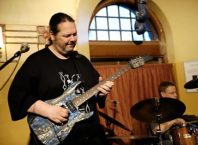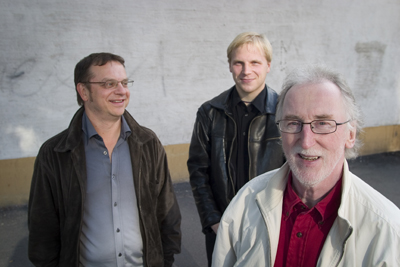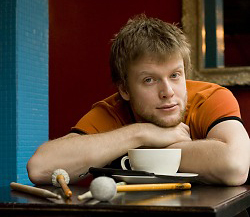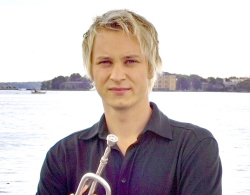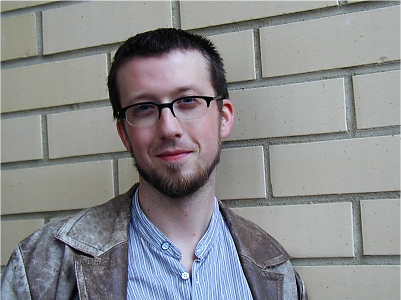
Törmäsin Matthew Wuethrichin nimeen sattumoisin jokin aika sitten etsiessäni aineistoa eräästä suomalaisesta yhtyeestä. Wuethrichin arvio All About Jazz -verkkolehdessä johti tutustumaan miehen muihinkin kirjoituksiin. Samaisesta AAJ:sta löytyikin monen monta mielenkiintoista juttua, esimerkiksi varmasti kattavin kirjoituskokoelma vuoden 2003 Tampere Jazz Happeningistä. Chicagosta kotoisin oleva Wuethrich on meren ylitettyään asunut Prahassa, Jerusalemissa ja Kotkassa ennen asettumistaan nykyiseen kotikaupunkiinsa Jyväskylään.
Haastattelu julkaistaan poikkeuksellisesti englanninkielisenä.
1. How did you end up in Finland? Tell the whole story!
OK, but you asked for it! The shorter, storybook version would read: We meet in Prague’s main square, my future Finnish wife stopping me for directions her first night in the city, we fall in love, get married, I move to Finland. Reality, as always, takes a few more twists and turns. We did meet on the streets of Prague, as I was living there and teaching English and she had come to study contemporary dance, but after her term ended she returned to Stockholm and I stayed in Prague. That started a year of living apart until we decided to move together to Jerusalem (another long story). We arrived just in time for the Second Intifada to begin, and after four months I returned to the States and Elina to Finland. After another few months apart I moved to Kotka where she was working as a lääneentaiteilija. After three months of a fruitless job search my tourist visa ran out, so we decided to finally get married. Another nine months in Kotk went, with me unemployed and studying Finnish in Inkeroinen, until a job opportunity opened up in Jyväskylä, which brings us to where we are now…
2. What are your activities now in Jyväskylä? Work, hobbies etc?
Monday to Friday (and some Sundays) I spend teaching and planning lessons for my work as an English trainer at AAC Global Oy, where I give courses in English for Business Purposes. I teach general courses, writing, presentations, negotiation language and various other types.
When I’m not getting Finnish people to speak English – and learning more about pulp, mobile phones, tractors, paper and IT than I ever thought – music and our Tibetan terrier get most of my attention. Listening to music, live and recorded, and writing about it is my main hobby, but I read quite a lot, fiction, non-fiction, magazines.
3. Tell us about All About Jazz. How did you get to write for AAJ?
AAJ is more a community than a website, a community of listeners, musicians and writers, and the format of the site allows all three groups to share ideas, thoughts, recommendations, whatever. The site is always looking for more content, and I found that there was next to nothing about Finnish jazz. As I was living in Kotka at the time and just beginning to discover Finnish music, I thought it would be a good way to learn about what was happening musically in this country. So I started raiding Kotka’s music library (which also showed me how extensive Finland’s public library system is.)
4. How did you become a jazz critic anyway?
Writing music articles combines my two passions, writing and music. I studied writing at the University Of Illinois, taking courses in creative writing, journalism and business communication. Music has mostly been from a listener’s perspective, but I did study electric bass during university and had lots of friends who also had music as hobby, so we often got together and experimented with all kinds of music, from free improvisation and rock to bluegrass and American roots music.
Music has meant many things to me at different times in my life – creative inspiration, a means to create community, and more recently I’ve started to see musical expressions and traditions as storehouses of history, culture and identity, where you can glimpse the terrain of the past in the present. Maybe that’s why jazz has always intrigued me, because as a form one can hear the changes of the twentieth-century so distinctly, but the individuals who make the music are free to draw on all time periods at any time in their playing, if they wish.
5. Do you have a total freedom in AAJ, to write about anything you wish, and as much as you want about Finnish music?
AAJ operates with a completely free editorial policy, meaning anyone with something to say can say it. I just recently started a new column called ’Nordic Sounds’, and I have the green light to write about any aspect of the Finnish music scene, and now about any Scandinavian country. In future, I want to broaden my focus and try to capture a little bit of each country.
6. What else do you listen to besides jazz?
I try to stay open to just about anything because I realize there is still a wealth of great music to be heard; rock, reggae, funk, American folk and country, soundtracks, electronica, Cuban, Brazilian, Balkan, Bach, 20th-century music – I listen to a little bit of everything. I often swing between really introverted atmospheres, l ike recently between György Ligeti, Supersilent and Kemialliset Ystävät, to more extroverted attitudes, like King Tubby, Kuusumun Profeetta, Circle and The Grateful Dead.
I try to keep a journal of what I listen to, and when I look through I am always surprised to see the range. One month will have Fado singer Amalia Rodrigues, Tom Waits and Johnny Cash, along with Charles Mingus, Mozart, Cecil Taylor and Fela Kuti, maybe even some Balinese Gamelan, John Fahey and solo oud.
I should say that I find a lot of inspiration in the library here, as I make trips probably weekly, taking the opportunity to experiment for new finds.
7. How is jazz situated in the field of music generally in the USA? Do you feel there are any differences between the USA, Europe, Finland?
There are a lot of people (musicians, critics, listeners) who would like jazz to be considered ”America’s Classical music,” which means they want to canonize certain artists and exclude others (see Ken Burn’s Jazz documentary for a classic example of this.) But there are just as many people – musicians, listeners and critics – who are still digging for ways to evolve the form.
From what I’ve seen this mainstream/underground dialogue is going on in Finland and the European countries I’ve experienced. For every jazz club offering swing, hot jazz and bebop revivals, there are festivals showing more modern sounds.
In general it’s a pity that this mainstream/underground distinction even exists, because it just ends up that people turn their noses up at other styles, and we end up missing some really pleasurable, exciting experiences. I wish music didn’t always have to feel like some kind of competition, where everyone runs around holding up their favourite music as the ’truth’, or trying to keep their discoveries to themselves.
8.There must be a lot of music in the field of American jazz that is not so well known here in Europe. What of the present day American jazz would you like to import to Finland, if you could for example decide on a festival programme?
If I wanted an edgier, more out festival I would want some of the groups coming out of Chicago, like the Chicago Underground projects with cornetist Rob Mazurek and guitarist Jeff Parker, or The Vandermark 5 for some fired-up free playing, or even tenor saxophonist Fred Anderson, a legend who is only now getting his due. From New York, pianist Matthew Shipp has some interesting projects going on. Saxophonist Ellery Eskelin’s trio with Zeena Parkins and Jim Black would also be great to see.
If I wanted people to really dance and just have a good time, I would say groups like Steve Bernstein’s Sex Mob, and the avant-groove trio MMW. Too often at festivals and concerts (in many countries) people feel inhibited, and these groups, with their energy and spirit, allow people to let loose. And just enjoy the music with their whole bodies.
9 .What was you first contact with Finnish jazz? First concerts here? Any funny feelings about the way music was played? Are you used to Finnish music now, or are there still surprises?
I bought Sound and Fury’s Nordic Gallery in Prague after meeting my wife. At first, the title and the cover confirmed my stereotypes of the Nordic countries: a bunch of straight-faced people wandering around in the snow, lots of pine trees, etc. But the music was something else entirely. Mutant tangos, strange vocalizations, a whole spectrum of instruments (accordions, electric and acoustic bass, guitar, clarinets, bells) moving in and out of the mix and extended angular melodies – totally foreign and not like anything I had heard before.
My first concert was a bass trio with Teppa Hauta-Aho at a lighthouse in Kotka. Not as strange as Vesala, but still a fresh experience. One of my early shows that remains really memorable was also in Kotka, it was a trio – Seppo Kantonen on piano, Ville Herrala on bass, Tom Nekljudow on drums and Yrjänä Sauros reciting poetry, telling riddles and playing harmonica. Totally surreal, especially because at the time I didn’t understand any Finnish, so it was just this blur of consonants and unfamiliar vowels against more recognizable musical forms.
I always feel that the vocal music (rock, pop, folk) of a foreign country holds its secrets longer than instrumental music. So much of the effect of vocal music is in the sound and meaning of the words and the way they are manipulated, and usually in ways that only native, or really experienced, speakers can fully appreciate.
10. What are the signs of locality, how is the grammar of Finnish jazz different from the one you have been used to earlier?
It depends on who one listens to. Composers like Vesala, Haarla and Mikkonen use elements that create surprising song structures, ones that seem to unique to Finland (The Kalevela, fusions of blues sonorities and older Finnish folk forms). But jazz by its nature incorporates elements from whatever is around it, and by becoming so global, it is quite natural to hear folk forms from many countries being used.
11. Can you name Finnish musicians or bands that have made the greatest impression on you?
Recently I’ve really enjoyed hearing Mikko Innanen play. It always sounds first and foremost like he’s enjoying himself, but at the same time he’s really dialoguing with the past: arguing with it, agreeing with it, respecting it – all at the same time. His recent tours with Delirium and Triade were fabulous.
Samuli Mikkonen’s large ensemble is also a stunning experience, where the sounds and atmosphere just overwhelm you. I also enjoy the Juhani Aaltonen Trio’s intimate atmospheres and listening to Karikko is also great fun, as it moves between chamber music, jazz and fusion in the space of a few bars.
Outside of jazz circles, I just saw Kuusumun Profeetta this past weekend and came away stunned. High-energy rock, subtle song structures, loose and almost jazzy keyboards and Mika Rättö’s sonic boom of a voice – easily one of the best performances I’ve seen in Finland. In January I saw a performance of Kari Saariaho’s music in Jyväskylä City Theatre. Absolutely spellbinding, almost ghostly music.
12. How does the cultural life of this small town of Jyväskylä feel? It must be a little different from your home Chicago?
You can’t even compare the two, and one shouldn’t. Chicago represents one kind of system of culture, whereas Jyväskylä represents another, and it’s one I enjoy a lot. The city where I went to university was quite similar to JKL, 80,000 people with a large university. In a smaller city, you see the people that are part of the culture on the street, and it makes the culture feel like its somehow closer to you and that you could even be a part of it. This feeling of participation is one that I feel gets lost these days, the distinctions between audience and artist have grown too large.
13. You wrote a lot of great articles about Tampere Jazz Happening 2003. Have you visited any other Finnish Jazz Festivals? Comments on them?
I caught Summer Jazz last year. There definitely a lot of variety, but one of the most interesting was the meeting between the English players, Chris Batchelor and Rob Townsend, and the Jyväskylä players. I think more meetings like that would be really good for jazz festivals, local and international players meeting and spontaneously interacting, with very little rehearsal. In general, I always like the side stages at festivals more, where more adventurous music is happening.
The Vapaat Äänet series run by Charles Gil, while not a festival per se, is a great idea, exposing audiences from both countries to new acts.
14. You write also for The Wire. What are your topics in that magazine? What are your plans for AAJ and writing in general?
Again, Finnish music has been my focus with the Wire. My first piece was a review of the Tampere festival, which appeared in the Feb 2004 issue. In June there should be a second article about the underground improvisation scene that has been developing in Helsinki, Tampere and Turku.
Writing for the Wire is a new development in my career, and one that I am quite excited about. Because it’s a print magazine, there are different considerations – such as space, writing style, audience – that differ from writing for the Web.
Internet writing should allow readers to get information much more quickly because the Web readers are more impatient, often skimming more than reading every single word. I am still trying to develop distinct styles for the two forms. Hopefully the Wire will allow me to write longer pieces.
In general, I just want to continue sharpening my writing skills and my ear, and find new things to hear and new ways to express them. Not being a musician both limits and frees me when writing. I can’t always analyze the music technically, so I have to look for other ways to describe what I hear, which broadens my picture of what the music means.
15. And finally, what is your personal top five of the Finnish jazz albums?
In no particular order, and likely to change…
Samuli Mikkonen + 7 henkeä
Iro Haarla + Pepa Päivinen: Yarra Yarra
Edward Vesala: Satu
Kari Ikonen: Karikko
Tomasz Stanko: Balladyna (OK, only one Finnish player, but Vesala’s drumming gives so much shape to all the pieces!
kysymykset: Pentti Ronkanen


